
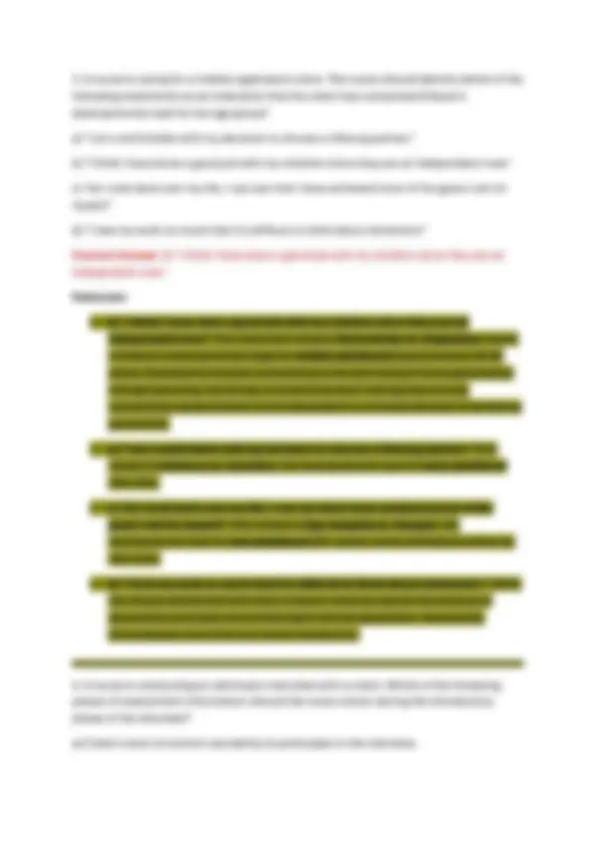
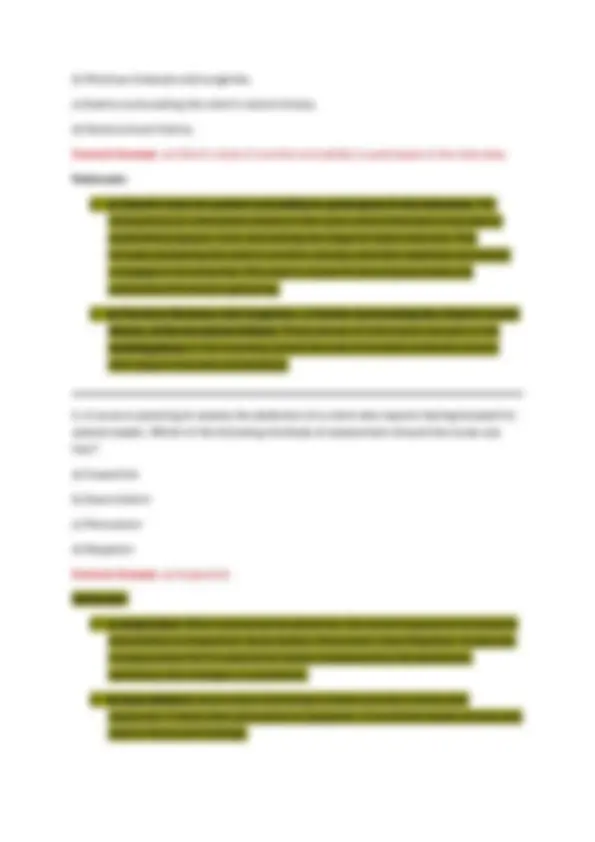
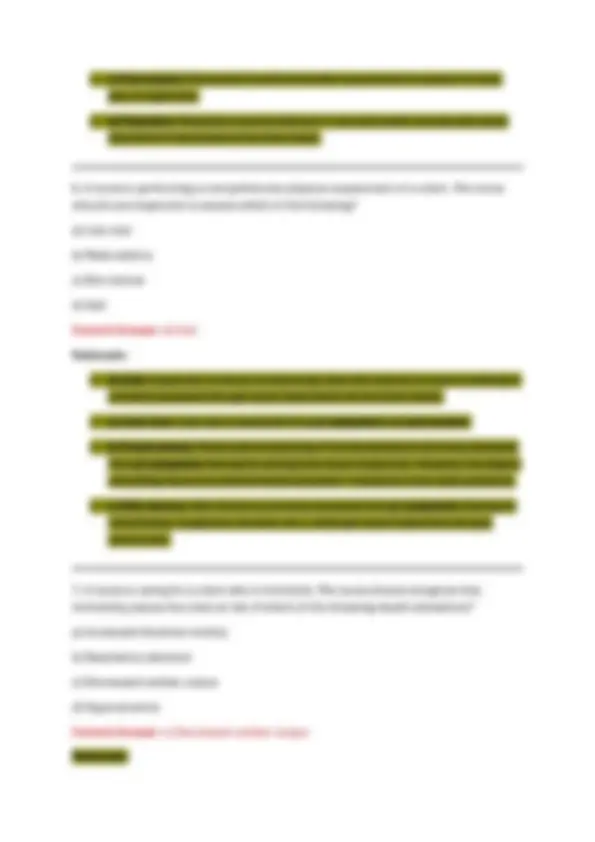

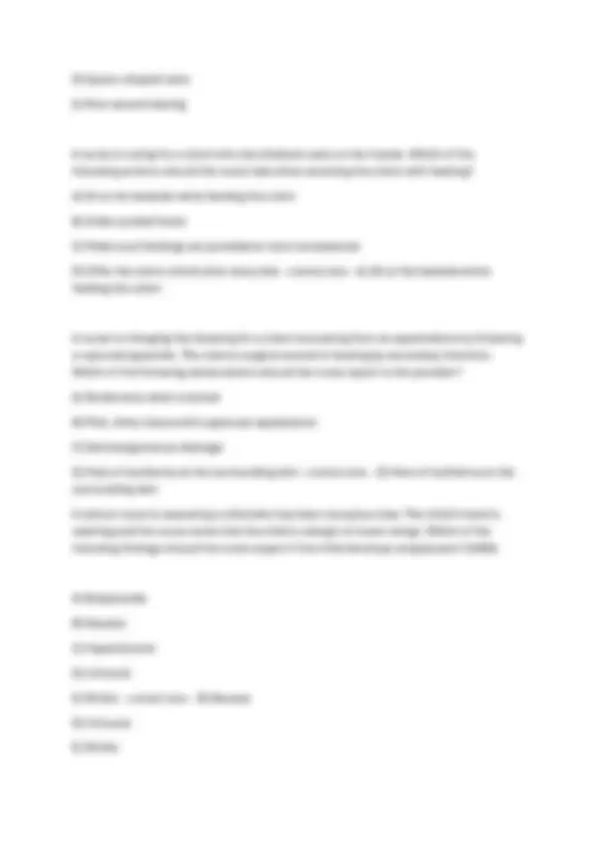
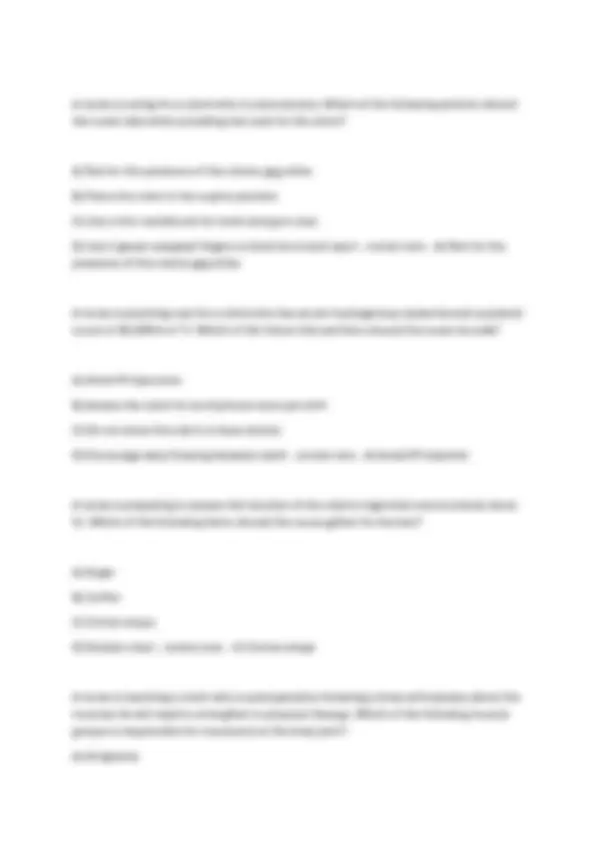
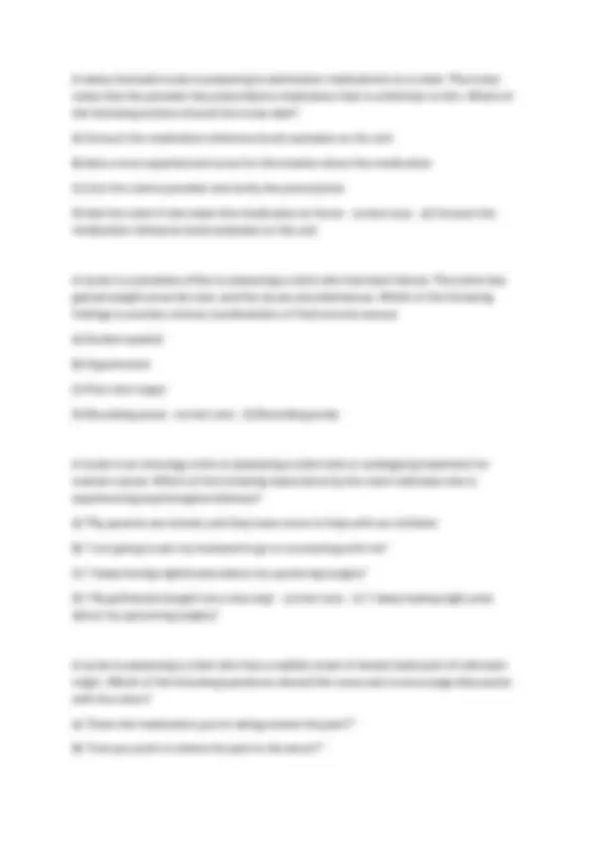
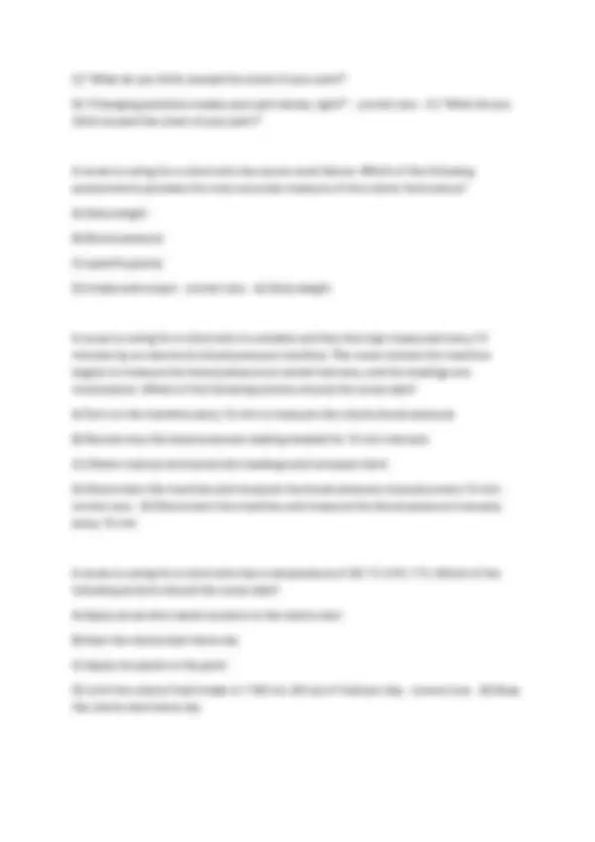
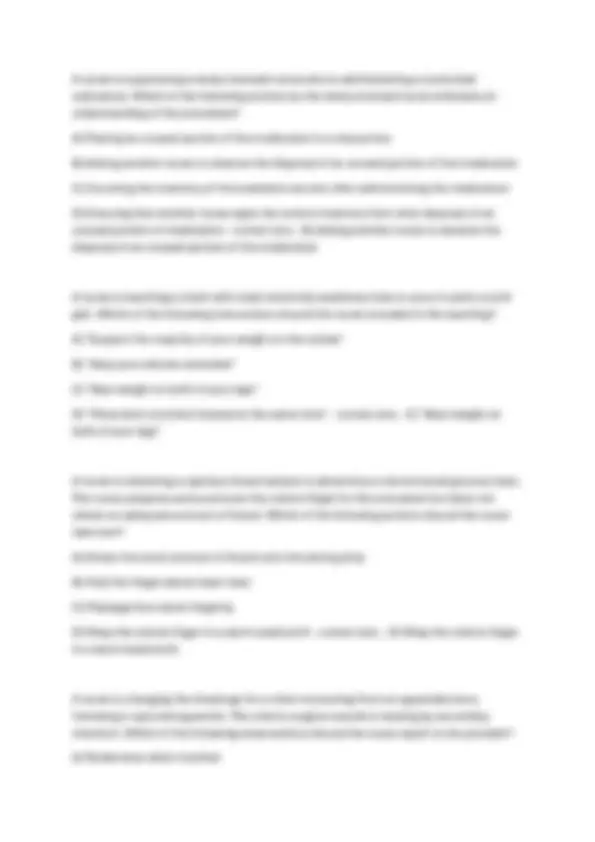
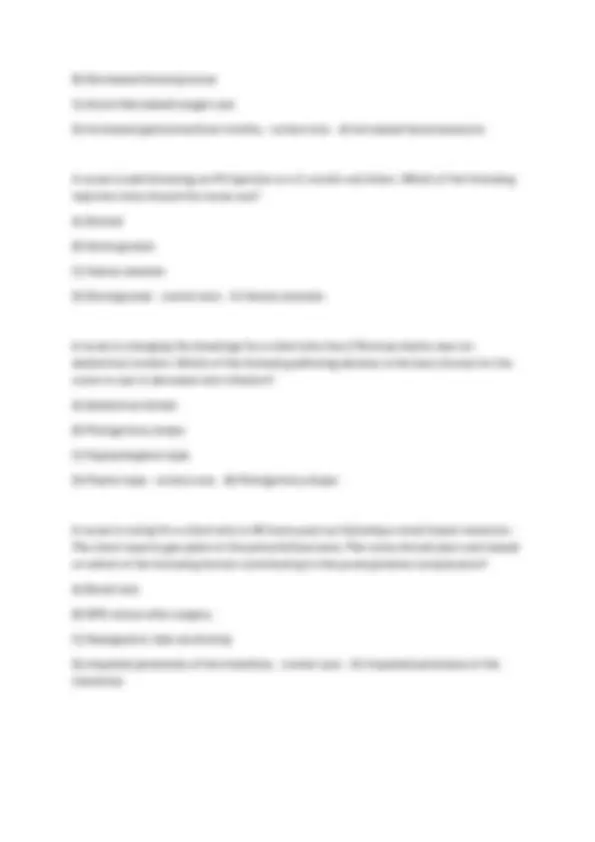
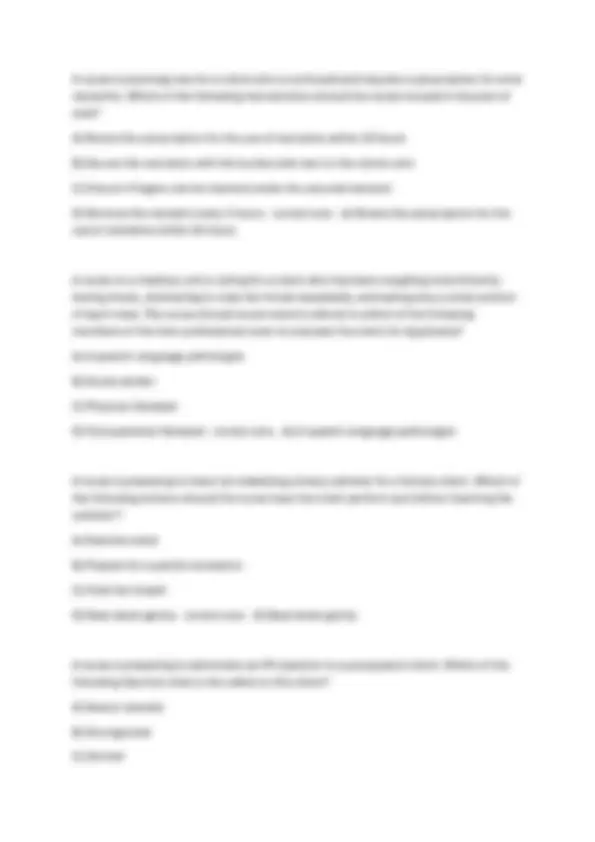
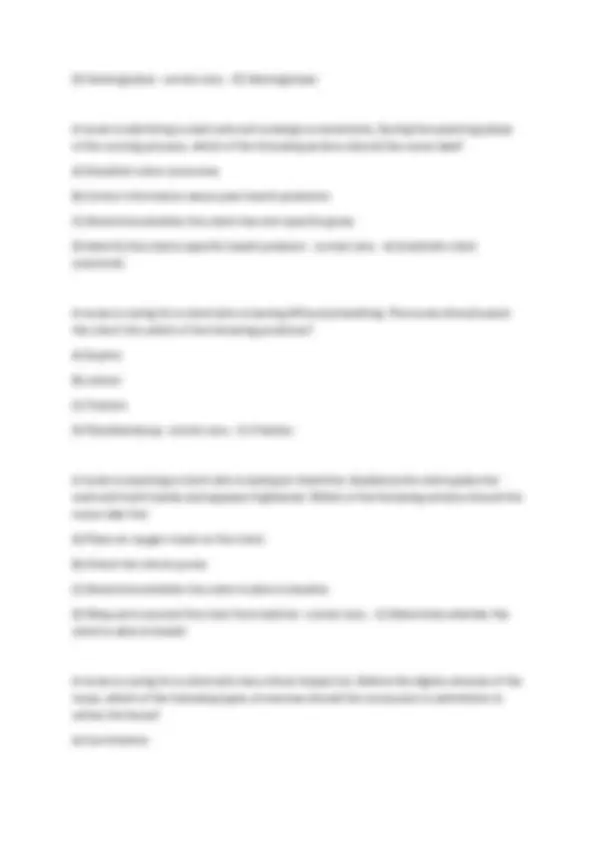
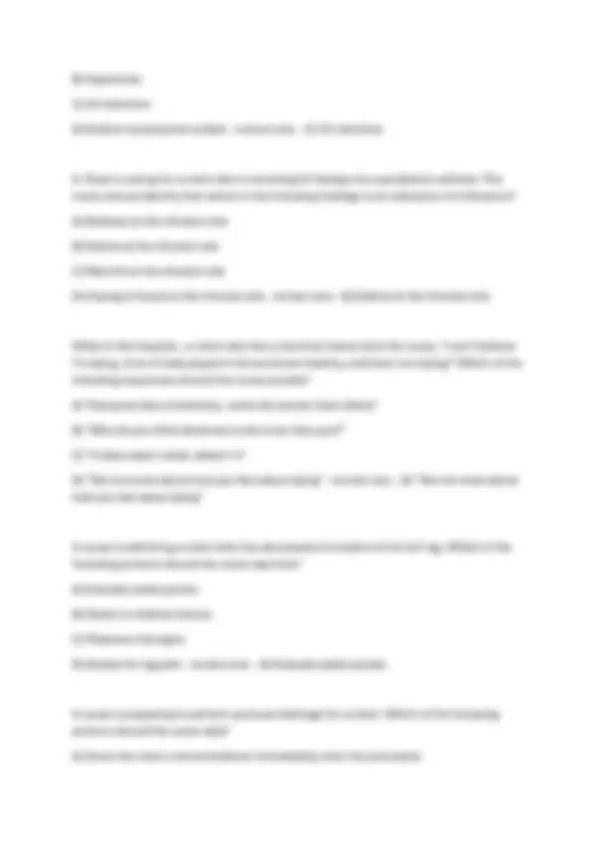
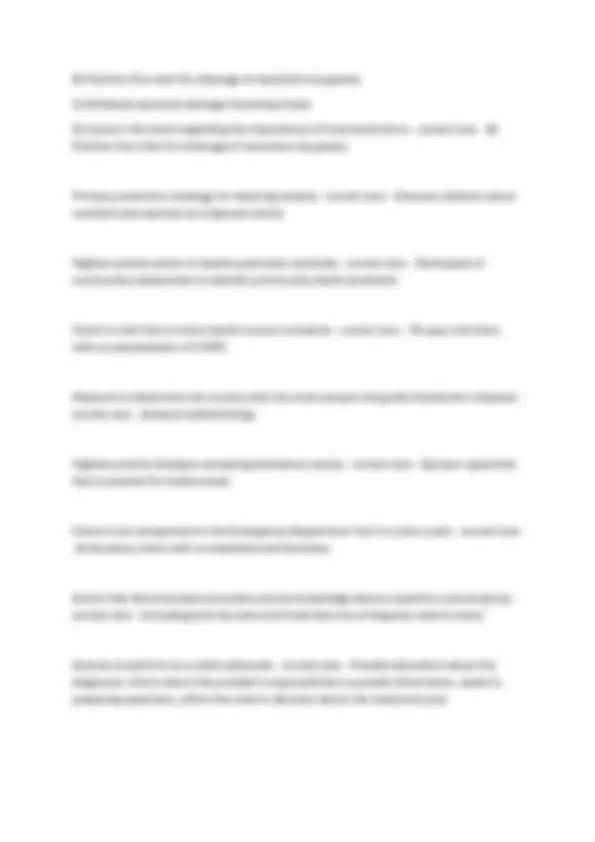
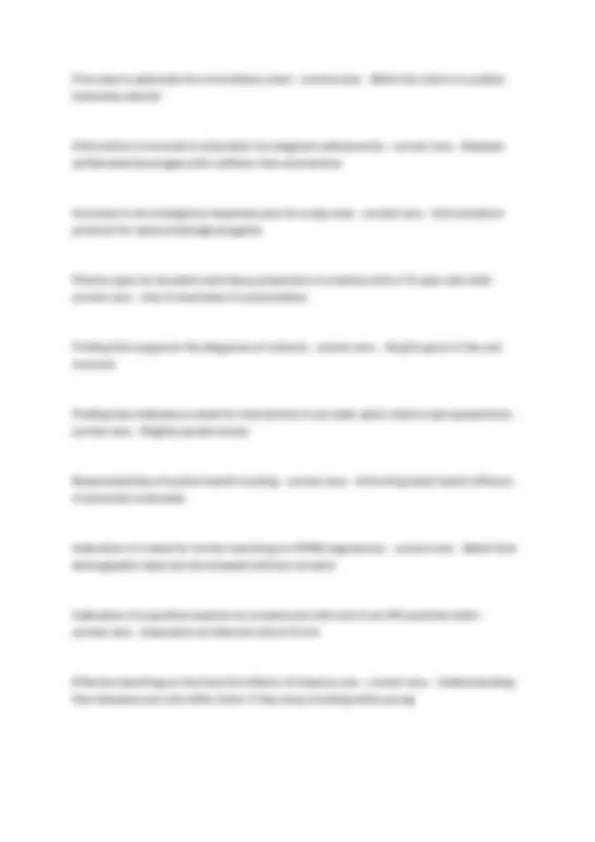
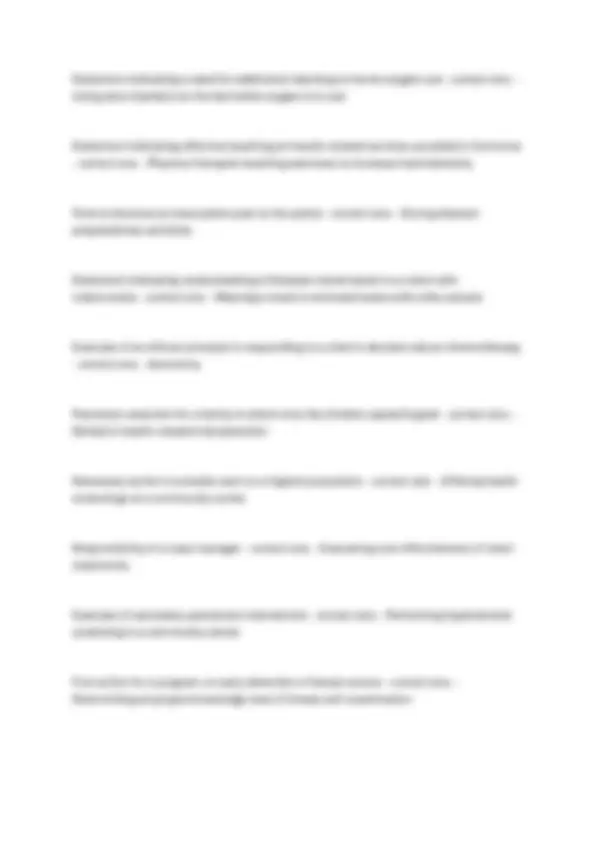
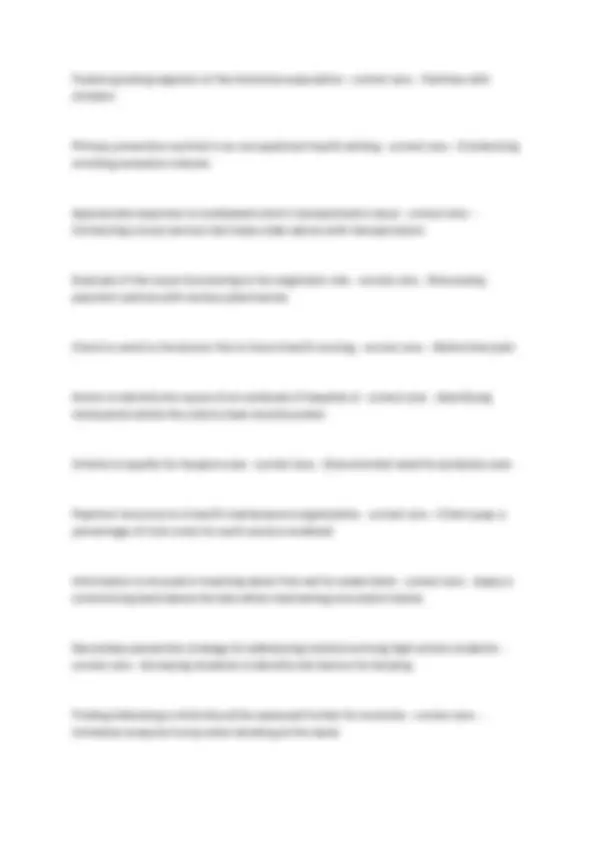
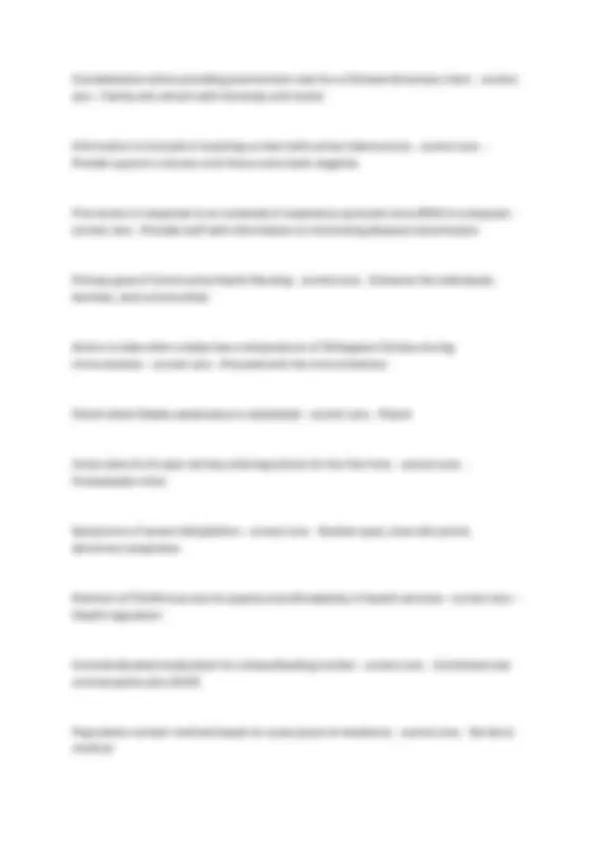
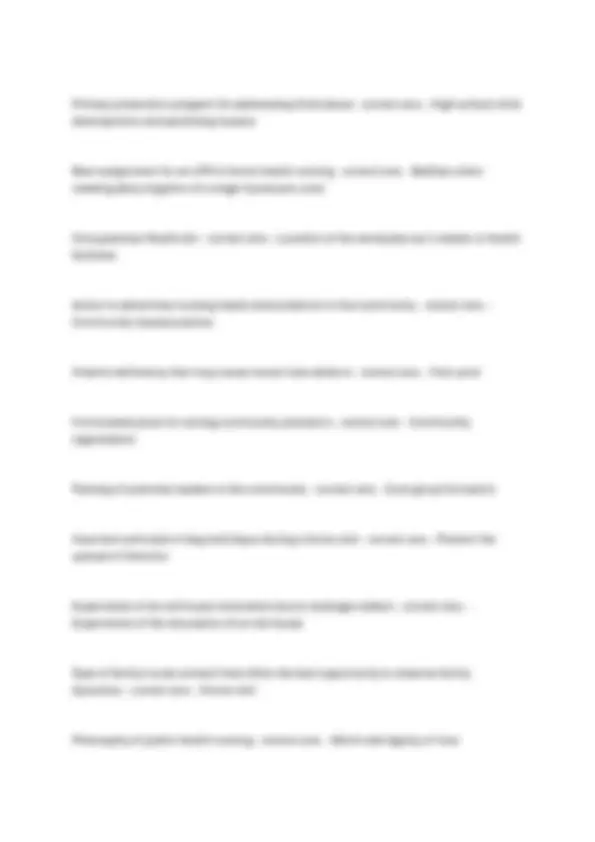
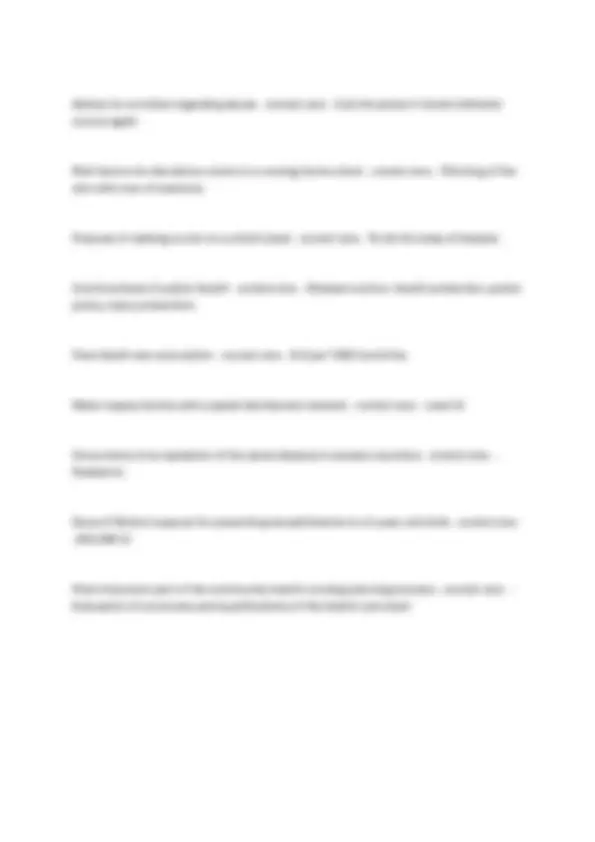


Study with the several resources on Docsity

Earn points by helping other students or get them with a premium plan


Prepare for your exams
Study with the several resources on Docsity

Earn points to download
Earn points by helping other students or get them with a premium plan
Community
Ask the community for help and clear up your study doubts
Discover the best universities in your country according to Docsity users
Free resources
Download our free guides on studying techniques, anxiety management strategies, and thesis advice from Docsity tutors
A.T.I Community Health Proctored Exam 2023 – Complete Test Bank with Real Questions and Verified Answers for the ATI Proctored Community Health Assessment
Typology: Exams
1 / 28

This page cannot be seen from the preview
Don't miss anything!





















Here are the multi-choice questions with rationales and indicated correct answers for the provided list.
b) Previous illnesses and surgeries. c) Events surrounding the client's recent illness. d) Sociocultural history. Correct Answer: a) Client's level of comfort and ability to participate in the interview. Rationale:
A nurse is assessing the pH of a clients gastric fluid to confirm the placement of an NG tube in the stomach. Which of the following pH values should the nurse expect? A) 6 B) 2 C) 10 D) 8 - correct ans- - B) 2 A nurse is caring for a client who is scheduled to receive transcutaneous electrical nerve (TENS) for pain management. The client asks the nurse how a TENS unit helps to relieve pain. Which of the following responses should the nurse make? A) "It provides a distraction from the pain" B) "It modulates the transmission of the pain impulse" C) "It promotes increased circulation to the painful area" D) "It elicits a relaxation response" - correct ans- - B) "It modulates the transmission of the pain impulse" A nurse is performing a physical assessment of a client. The nurse should recognize that which of the following places the client at risk of impaired skin integrity? A) 3+ Achilles reflex B) Faint pedal pulses C) Feet warm to the touch bilaterally D) Capillary refill of <2 seconds - correct ans- - B) Faint pedal pulse A nurse is assessing a client. Which of the following findings should the nurse identify as an indication of protein-calorie malnourishment (SATA) A) Gingivitis B) Dry, brittle hair C) Edema D) Spoon-shaped nails E) Poor wound healing - correct ans- - B) Dry, brittle hair
A nurse is caring for a client who is unconscious. Which of the following actions should the nurse take when providing oral care for the client? A) Test for the presence of the clients gag reflex B) Place the client in the supine position C) Use a firm toothbrush for tooth and gum care D) Use 2 gauze-wrapped fingers to hold the mouth open - correct ans- - A) Test for the presence of the clients gag reflex A nurse is planning care for a client who has acute myelogenous leukemia and a platelet count of 48,000/mm^3. Which of the follow interventions should the nurse include? A) Avoid IM injections B) Assess the client for ecchymosis once per shift C) Do not allow the client to have visitors D) Encourage daily flossing between teeth - correct ans- - A) Avoid IM injection A nurse is preparing to assess the function of the clients trigeminal nerve (cranial nerve V). Which of the following items should the nurse gather for the test? A) Sugar B) Coffee C) Cotton wisps D) Snellen chart - correct ans- - C) Cotton wisps A nurse is teaching a client who is postoperative following a knee arthroplasty about the muscles he will need to strengthen in physical therapy. Which of the following muscle groups is responsible for movement at the knee joint? A) Antigravity
B) Antagonistic C) Synergistic D) Skeletal - correct ans- - B) Antagonistic A nurse is caring for a client who has a terminal illness. The family wants to care for the client at home. Which of the following statements indicates that the nurse understands family-centered care A) "Social services can contact various community resources that will be helpful." B) "I will review the care plan to make the necessary changes." C) "Let's set up a meeting time with the doctor to discuss your options for home care." D) "I will make a list of things we need to do before discharge." - correct ans- - C) "Let's set up a meeting time with the doctor to discuss your options for home care." A nurse has received a prescription for dextran to administer to a client. The nurse should recognize that dextran belongs in which of the following functional classifications A) Skeletal muscle relaxants B) Beta-adrenergic blockers C) Broad-spectrum anti-infective agents D) Plasma volume expanders - correct ans- - D) Plasma volume expanders A nurse is providing teaching to a client regarding protein intake. Which of the following foods should the nurse include as an example of an incomplete protein? A) Eggs B) Soybeans C) Lentils D) Yogurt - correct ans- - D) Lentils A nurse is caring for a client who has cancer and is experiencing pain. The nurse should implement which of the following interventions to assist the client with pain relief?
A newly licensed nurse is preparing to administer medications to a client. The nurse notes that the provider has prescribed a medication that is unfamiliar to him. Which of the following actions should the nurse take? A) Consult the medication reference book available on the unit B) Ask a more experienced nurse for information about the medication C) Call the clients provider and verify the prescription D) Ask the client if she takes this medication at home - correct ans- - A) Consult the medication reference book available on the unit A nurse in a providers office is assessing a client who has heart failure. The client has gained weight since her last, and her an,les are edematous. Which of the following findings is another clinical manifestation of fluid volume excess A) Sunken eyeball B) Hypotension C) Poor skin turgor D) Bounding pulse - correct ans- - D) Bounding pulse A nurse in an oncology clinic is assessing a client who is undergoing treatment for ovarian cancer. Which of the following statements by the client indicates she is experiencing psychological distress? A) "My parents are retired, and they have come to help with our children B) "I am going to ask my husband to go to counseling with me" C) "I keep having nightmares about my upcoming surgery" D) "My girlfriends bought me a nice wig" - correct ans- - C) "I keep having night,ares about my upcoming surgery" A nurse is assessing a client who has a sudden onset of severe back pain of unknown origin. Which of the following questions should the nurse ask to encourage discussion with the client? A) "Does the medication you're taking relieve the pain?" B) "Can you point to where the pain is the worst?"
C) "What do you think caused the onset of your pain?" D) "Changing positions makes your pain worse, right?" - correct ans- - C) "What do you think caused the onset of your pain?" A nurse is caring for a client who has acute renal failure. Which of the following assessments provides the most accurate measure of the clients fluid status? A) Daily weight B) Blood pressure C) specific gravity D) Intake and output - correct ans- - A) Daily weight A nurse is caring for a client who is unstable and has vital sign measured every 15 minutes by an electronic blood pressure machine. The nurse notices the machine begins to measure the blood pressure at varied intervals, and the readings are inconsistent. Which of the following actions should the nurse take? A) Turn on the machine every 15 min to measure the clients blood pressure B) Record only the blood pressure reading needed for 15 min intervals C) Obtain manual and automatic readings and compare them D) Disconnect the machine and measure the blood pressure manually every 15 min - correct ans- - D) Disconnect the machine and measure the blood pressure manually every 15 min A nurse is caring for a client who has a temperature of 38.7 C (101.7 F). Which of the following actions should the nurse take? A) Apply an alcohol-water solution to the clients skin B) Keel the clients bed linens dry C) Apply ice packs to the groin D) Limit the clients fluid intake to 1183 mL (40 oz) of fluid per day - correct ans- - B) Keep the clients bed linens dry
B) Pink, shiny tissue with a granular appearance C) Serosanguineous drainage D) Halo of erythema on the surrounding skin - correct ans- - D) Halo of erythema on the surrounding skin A nurse is caring for an adult client who has an NG tube in place and a prescription for continuous enteral feedings. Which of the following actions should the nurse perform to reduce the clients risk of aspiration A) Irrigate the tubing with 30ml of sterile water B) Elevate the head of the bed to 30 degrees or 45 degrees C) Suggest changing the feeding to lactose - free formula D) Warm the enteral formula to room temperature before feeding - correct ans- - B) Elevate the head of the bed to 30 degrees or 45 degrees A nurse is auscultating a clients lungs and identifies rhonchi over the trachea and bronchi. Which of the following actions should the nurse take? A) Limit the clients fluid intake B) Assist the client into a supine position C) Administer oxygen at 2 L/min D) Encourage the client to cough - correct ans- - D) Encourage the client to cough During a client care staff meeting, a nurse manager discusses potential problems with data security that affect confidential client information. Which of the following environments should the nurse manager, identify as an acceptable place for discussing clients information? A) Areas with no public access B) Outside the door of a clients room C) In the cafeteria during break D) In the hallway near the nurses station - correct ans- - A) Areas with no public access
A nurse is caring for a client who has a terminal illness. Which of the following findings indicates the clients death is imminent? A) Urinary retention B) Cold extremities C) Hypertension D) Tachycardia - correct ans- - B) Cold extremities A nurse is reviewing the laboratory values of a client who has a positive Chvosteks sign. Which of the following laboratory findings should the nurse expect? A) Decreased calcium B) Decreased potassium C) Increased potassium D) Increased calcium - correct ans- - A) Decreased calcium A nurse is preparing to administer a unit of packed RBC to a client. Which of the following pieces of information must the nurse verify with another nurse prior to administration? (SATA) A) The clients ID number B) The clients room number C) The clients name D) ABO compatibility E) Rh compatibility - correct ans- - A) The clients ID number B) The clients name D) ABO compatibility E) Rh compatibility A nurse is assessing a client who is experiencing stress and anxiety regarding a recent diagnosis. Which of the following findings should the nurse expect? A) Increased blood pressure
A nurse is planning care for a client who is confused and requires a prescription for wrist restraints. Which of the following interventions should the nurse include in the plan of care? A) Renew the prescription for the use of restraints within 24 hours B) Secure the restraints with the buckle side next to the clients skin C) Ensure 4 fingers can be inserted under the secured restraint D) Remove the restraint every 3 hours - correct ans- - A) Renew the prescription for the use of restraints within 24 hours A nurse on a medical unit is caring for a client who has been coughing intermittently during meals, attempting to clear her throat repeatedly, and eating only a small portion of each meal. The nurse should recommend a referral to which of the following members of the inter professional team to evaluate the client for dysphasia? A) A speech-language pathologist B) Social worker C) Physical therapist D) Occupational therapist - correct ans- - A) A speech-language pathologist A nurse is preparing to insert an indwelling urinary catheter for s female client. Which of the following actions should the nurse have the client perform just before inserting the catheter? A) Swallow water B) Prepare for a painful sensation C) Hold her breath D) Near down gently - correct ans- - D) Bear down gently A nurse is preparing to administer an IM injection to a young adult client. Which of the following injection sites is the safest to this client? A) Vastus lateralis B) Dorsogluteal C) Deltoid
D) Ventrogluteal - correct ans- - D) Ventrogluteal A nurse is admitting a client who will undergo a craniotomy. During the planning phase of the nursing process, which of the following actions should the nurse take? A) Establish client outcomes B) Collect information about past health problems C) Determine whether the client has met specific goals D) Identify the clients specific health problem - correct ans- - A) Establish client outcomes A nurse is caring for a client who is having difficulty breathing. The nurse should assist the client into which of the following positions? A) Supine B) Lateral C) Fowlers D) Trendelenburg - correct ans- - C) Fowlers A nurse is assisting a client who is eating at mealtime. Suddenly the client grabs her neck with both hands and appears frightened. Which of the following actions should the nurse take first A) Place an oxygen mask on the client B) Check the clients pulse C) Determine whether the client is able to breathe D) Wrap arms around the client from behind - correct ans- - C) Determine whether the client is able to breath A nurse is caring for a client who has a fecal impact ion. Before the digital removal of the mass, which of the following types of enemas should the nurse plan to administer to soften the feces? A) Carminative